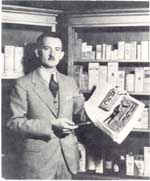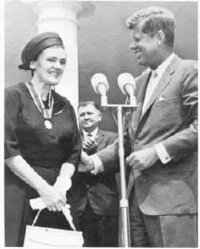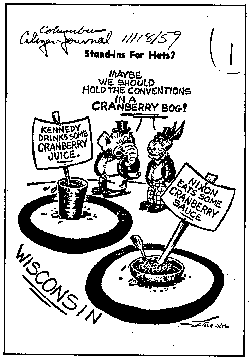Part II
1938--The Federal Food, Drug, and Cosmetic Act

Chief Inspector George P. Larrick in the "Chamber of Horrors " exhibit Table of Contents
|
Part II
1938--The Federal Food, Drug, and Cosmetic Act

Chief Inspector George P. Larrick in the "Chamber of Horrors " exhibit Table of Contents
|
1938--The Federal Food, Drug, and Cosmetic Act
The six-page Wiley law prohibited the manufacture and interstate shipment of "adulterated" and "misbranded" foods and drugs. It enabled the Government to go to court against illegal products but lacked affirmative requirements to guide compliance. Labels were not even required to state the weight or measure -- only that a contents statement, if used, must be truthful. By 1913, food manufacturers, alarmed by growing variety of State weight and measure laws, sought uniformity through the Gould Amendment to the Federal law -- requiring net contents to be declared, with tolerances for reasonable variations.
False therapeutic claims for patent medicines had escaped control in 1912 when Congress enacted an amendment outlawing such claims but requiring the Government to prove them fraudulent; i.e., that the promoter intended to swindle his victims. A defendant had only to show that he personally believed in his fake remedy to escape prosecution -- a major weakness in the law for 26 years.
Food adulteration continued to flourish because judges could find no specific authority in the law for the standards of purity and content which FDA had set up. Such products as "fruit" jams made with water, glucose, grass seed, and artificial color undercut the market for honest products.
Economic hardships of the 1930's magnified the many shortcomings of the 1906 act and brought a new consciousness of consumer needs. The book YOUR MONEY'S WORTH, by Stuart Chase and F. J. Schlink, signaled the start of a new consumer movement.
Most important, the 1906 law became obsolete because of the technological changes which were revolutionizing the production and marketing of foods, drugs, and related products.
In 1933, a few days after the inauguration of Franklin D. Roosevelt as President of the United States, the chief of the Food and Drug Administration, Walter Campbell, seized an opportunity to discuss the food and drug situation with Rexford Tugwell, a member of the President's "brain trust," who had been named Assistant Secretary of Agriculture. The same afternoon Campbell was again called to Tugwell's office. "Mr. Campbell," said Tugwell, "since I saw you this morning I have talked with the President. I repeated our conversation to him, and he has authorized a revision of the Food and Drugs Act."
The "Tugwell bill," introduced in congress a few weeks later, was a legislative disaster. The opposition of industry and advertising interests to this New Deal legislation was total and overwhelming. When the smoke cleared away the Senate sponsor, Royal S. Copeland, M.D., of New York, aided by FDA officials, consumer-minded Congressmen, attorneys, and staff members, began the laborious process of fashioning a bill that could be enacted, yet not surrender essential consumer protection. A bitter 5-year legislative battle began. Again, organized club women provided most of the public support. Trade leaders made positive as well as negative contributions. Again public opinion was aroused by a shocking disclosure -- the deaths of more than 100 people from a poisonous "elixir of sulfanilamide." On June 25, 1938, President Roosevelt signed the Federal Food, Drug, and Cosmetic Act.

Chief Inspector George P. Larrick, later FDA commissioner, in the "Chamber of Horrors" exhibit, which he assembled for Senate hearings on the legislation that became the Federal Food, Drug, and Cosmetic Act of 1938. |
Ruth De Forest Lamb. FDA's chief educational officer, who
organized consumer support for the 1938 law and wrote THE
AMERICAN CHAMBER OF HORRORS , FDA's version of 100,000,000
GUINEA PIGS.

|

Frances O. Kelsey, M. D., the FDA medical officer who relied on the 1938 "new drug" law to refuse approval of thalidomide for marketing in the United States, receiving the Distinguished Federal Civilian Service Award from President John F. Kennedy, August 7, 1962. |
Many compromises had to be made to secure passage, but still the new law was a major improvement.
The following is a list of a few of some 40 substantive changes which altered the law to fit the new conditions.
The Preventive Amendments
The new law, and World War II, greatly expanded FDA's workload. Wartime demands had stimulated the development of new "wonder drugs," especially the antibiotics, which were made subject to FDA testing beginning with penicillin in 1945. Fortunately there was a law requiring premarket clearance of new drugs, but consumers continued to be guinea pigs for a host of new chemical compounds of unknown safety. The law prohibited poisonous substances but required no showing that food ingredients were safe. It provided for exemptions and safe tolerances for unavoidable or necessary poisons such as pesticides, but when FDA attempted to set a pesticide tolerance an adverse court decision showed that the lengthy procedure required by law was unworkable. FDA could stop the use of known poisons, and did so in numerous cases, but the vast research efforts needed to assure that all food chemicals were safe was clearly beyond all foreseeable resources.
In 1949, FDA Commissioner Paul B. Dunbar took the problem to a friend in Congress, Rep. Frank B. Keefe of Wisconsin. Mr. Keefe introduced a resolution to investigate chemicals in food, and later, cosmetics. The hearings, chaired by Rep. James T. Delaney of New York, went on for 2 years. From the committee's work came three amendments that fundamentally changed the character of the U.S. food and drug law: the Pesticide Amendment (1954), the Food Additives Amendment (1958), and the Color Additive Amendments (1960).
With these laws on the books, it could be said for the first time that no substance can legally be introduced into the U.S. food supply unless there has been a prior determination that it is safe. By requiring the manufacturers to do the research, a problem of unmanageable size was made manageable. Preventing violations through premarket clearance gave consumers immeasurably better protection than merely prosecuting the few violations which could be proved by investigating after injuries were reported.
Very significant was a proviso in the food and color additive laws that no additive could be deemed safe (or given FDA approval) if found to cause cancer in man or experimental animals. Known as the "Delaney Clause," the section was initially opposed by FDA and by scientists who agreed that an additive used at very low levels need not necessarily be banned because it may cause cancer at high levels. Proponents justified the clause on the basis that cancer experts have not been able to determine a safe level for any carcinogen. This was the underlying basis in 1959 for a nationwide FDA recall of cranberries contaminated by the weedkiller aminotriazole. Notwithstanding publicity critical of FDA, this action has beneficial results, particularly in convincing farmers that pesticides must be used with care. Other important and controversial FDA actions stemming from the Delaney Clause will be mentioned later.

|
The November 1959 cranberry recall gave cartoonists an opportunity to poke fun at both regulators and politicians. Between Thanksgiving and Christmas the FDA chemists worked 24 hours a day, testing the entire crop for contamination by a carcinogenic weedkiller. |